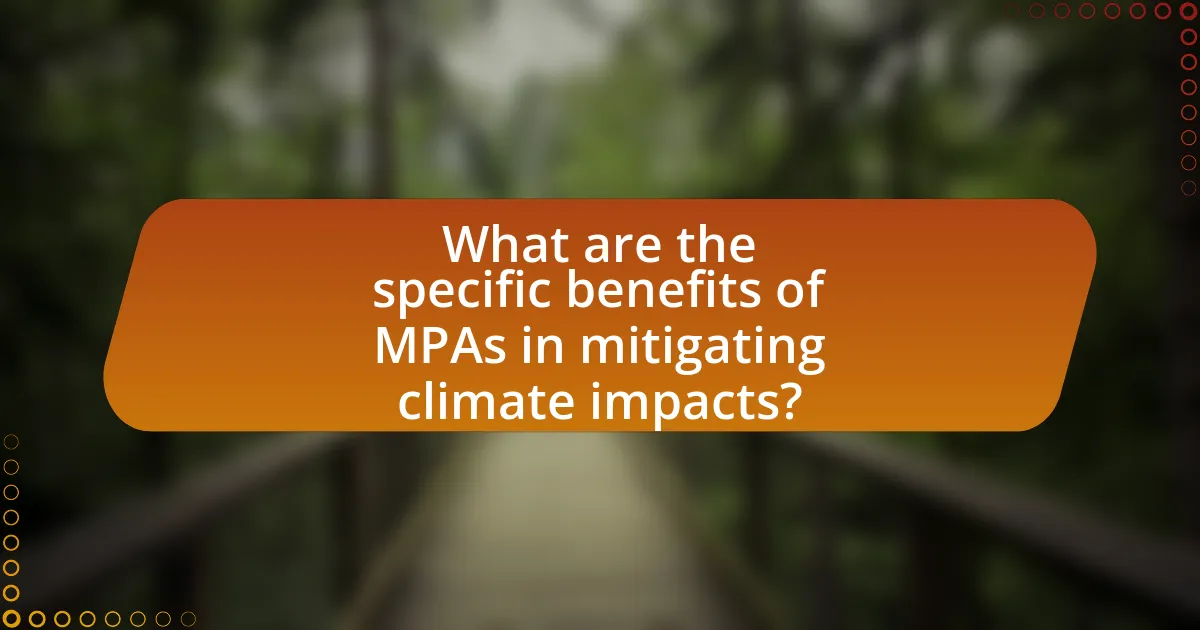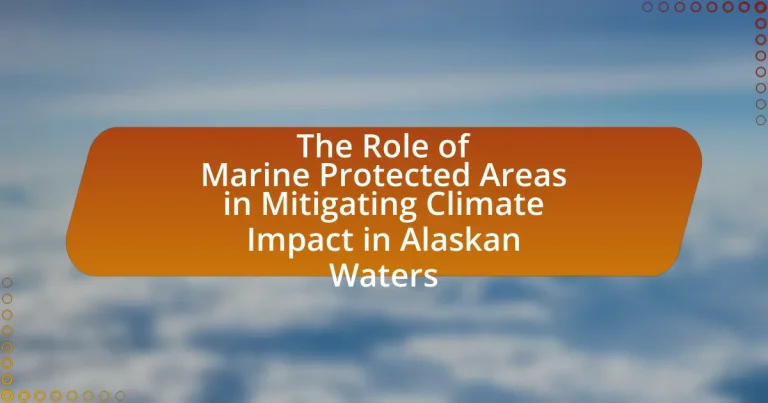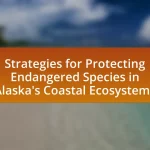Marine Protected Areas (MPAs) are designated regions in Alaskan waters aimed at conserving biodiversity and ecosystems by regulating human activities. This article examines the significance of MPAs in protecting vital habitats, enhancing resilience against climate change, and supporting sustainable fisheries. It discusses how MPAs function to mitigate threats such as ocean acidification and rising sea temperatures, while also highlighting their role in increasing fish populations and promoting ecosystem health. Additionally, the article addresses the challenges faced by MPAs, including pollution and overfishing, and emphasizes the importance of community engagement and adaptive management strategies for effective conservation.
-and-their-significance-in-Alaskan-waters-1.webp)
What are Marine Protected Areas (MPAs) and their significance in Alaskan waters?
Marine Protected Areas (MPAs) are designated regions in marine environments where human activities are regulated to conserve biodiversity and ecosystems. In Alaskan waters, MPAs play a crucial role in protecting vital habitats, such as coral reefs and fish spawning grounds, which are essential for maintaining healthy marine populations. The significance of MPAs in this region is underscored by their ability to enhance resilience against climate change impacts, such as ocean acidification and temperature fluctuations, thereby supporting sustainable fisheries and preserving cultural heritage linked to marine resources. Studies indicate that MPAs can lead to increased fish biomass and diversity, which are critical for the ecological balance and economic stability of coastal communities in Alaska.
How do MPAs function in the context of climate change?
Marine Protected Areas (MPAs) function as critical tools for enhancing the resilience of marine ecosystems in the context of climate change. By restricting human activities such as overfishing and habitat destruction, MPAs help maintain biodiversity and ecosystem health, which are essential for adapting to changing environmental conditions. Research indicates that MPAs can improve the resilience of marine species to climate stressors, such as ocean acidification and temperature fluctuations, by providing safe havens where populations can thrive and recover. For instance, studies have shown that fish populations within MPAs are often larger and more diverse, which contributes to overall ecosystem stability and enhances the ability of these systems to withstand climate impacts.
What specific roles do MPAs play in protecting marine biodiversity?
Marine Protected Areas (MPAs) play crucial roles in protecting marine biodiversity by providing safe habitats, reducing human impacts, and facilitating ecosystem recovery. MPAs create zones where fishing and other extractive activities are limited or prohibited, allowing species populations to rebound and maintain genetic diversity. For instance, studies have shown that MPAs can lead to a 20-50% increase in fish biomass within their boundaries, which supports overall ecosystem health. Additionally, MPAs help preserve critical habitats such as coral reefs and seagrass beds, which are essential for many marine species. By mitigating stressors like overfishing and habitat destruction, MPAs contribute significantly to the resilience of marine ecosystems, particularly in the face of climate change impacts observed in Alaskan waters.
How do MPAs contribute to ecosystem resilience against climate impacts?
Marine Protected Areas (MPAs) enhance ecosystem resilience against climate impacts by preserving biodiversity and promoting healthy marine habitats. By restricting harmful activities such as overfishing and habitat destruction, MPAs allow ecosystems to recover and adapt to changing environmental conditions. Research indicates that areas with strong protection show greater biodiversity, which is crucial for ecosystem stability and resilience. For instance, a study published in “Nature” by Edgar et al. (2014) found that MPAs can increase fish biomass by an average of 600%, thereby supporting more robust food webs and enhancing the overall health of marine ecosystems. This increased biodiversity and habitat integrity enable ecosystems to better withstand and recover from climate-related stressors, such as ocean acidification and temperature fluctuations.
Why are MPAs crucial for the sustainability of Alaskan marine ecosystems?
Marine Protected Areas (MPAs) are crucial for the sustainability of Alaskan marine ecosystems because they provide essential habitats for diverse marine species and help maintain ecological balance. MPAs protect critical breeding, feeding, and nursery grounds, which are vital for the life cycles of fish and other marine organisms. Research indicates that areas designated as MPAs can experience increased biodiversity and biomass, as seen in studies conducted by the National Oceanic and Atmospheric Administration, which found that MPAs in Alaska support healthier fish populations and enhance resilience against climate change impacts. By limiting human activities such as overfishing and habitat destruction, MPAs contribute to the long-term health and sustainability of these ecosystems, ensuring that they can withstand environmental changes and continue to provide resources for future generations.
What threats do Alaskan waters face due to climate change?
Alaskan waters face significant threats due to climate change, including ocean acidification, rising sea temperatures, and altered marine ecosystems. Ocean acidification, driven by increased carbon dioxide absorption, threatens shellfish populations and disrupts food webs. Rising sea temperatures lead to habitat loss for cold-water species and promote harmful algal blooms, which can impact fish populations and marine mammals. Additionally, altered marine ecosystems result in shifts in species distribution, affecting local fisheries and indigenous communities reliant on these resources. These changes are evidenced by studies showing a 30% increase in ocean acidity in the North Pacific since the late 18th century and rising sea surface temperatures by approximately 1.5 degrees Celsius over the past century.
How do MPAs mitigate these threats effectively?
Marine Protected Areas (MPAs) effectively mitigate threats to marine ecosystems by restricting harmful activities such as overfishing, habitat destruction, and pollution. By establishing no-take zones and regulating fishing practices, MPAs help restore fish populations and biodiversity, which are crucial for ecosystem resilience against climate change. Research indicates that MPAs can enhance the recovery of marine species, with studies showing that fish biomass can increase by up to 600% in well-managed MPAs compared to unprotected areas. Additionally, MPAs contribute to carbon sequestration by preserving critical habitats like seagrasses and mangroves, which absorb carbon dioxide. This multifaceted approach not only protects marine life but also strengthens the overall health of ocean ecosystems in the face of climate impacts.

What are the specific benefits of MPAs in mitigating climate impacts?
Marine Protected Areas (MPAs) provide specific benefits in mitigating climate impacts by enhancing biodiversity, protecting critical habitats, and increasing ecosystem resilience. These areas serve as refuges for marine species, allowing populations to recover and adapt to changing environmental conditions. Research indicates that MPAs can improve the health of marine ecosystems, which in turn supports carbon sequestration processes. For example, healthy kelp forests and seagrass beds, often found within MPAs, are known to absorb significant amounts of carbon dioxide, thus contributing to climate change mitigation. Additionally, MPAs help buffer against the effects of ocean acidification and temperature fluctuations, providing a more stable environment for marine life. Studies have shown that ecosystems within MPAs are generally more resilient to climate stressors, leading to better overall health and sustainability of marine resources.
How do MPAs enhance fish populations and marine life?
Marine Protected Areas (MPAs) enhance fish populations and marine life by providing a refuge from fishing pressures and habitat degradation. By restricting or prohibiting fishing activities, MPAs allow fish stocks to recover and grow, leading to increased biomass and biodiversity. Research indicates that MPAs can lead to a 20-50% increase in fish populations within their boundaries compared to unprotected areas. Additionally, MPAs help maintain ecosystem health by preserving critical habitats, such as coral reefs and seagrass beds, which are essential for the life cycles of many marine species. This protection fosters resilience against climate change impacts, ensuring sustainable marine ecosystems in Alaskan waters.
What evidence supports the effectiveness of MPAs in increasing biodiversity?
Marine Protected Areas (MPAs) effectively increase biodiversity, as evidenced by numerous studies demonstrating significant increases in species richness and abundance within their boundaries. For instance, a meta-analysis by Edgar et al. (2014) published in “Nature” found that MPAs can lead to a 20-50% increase in fish biomass compared to unprotected areas. Additionally, research conducted in Alaskan waters has shown that MPAs contribute to the recovery of overfished species, enhancing overall ecosystem health and resilience. These findings underscore the role of MPAs in fostering biodiversity and supporting marine ecosystems in the face of climate change.
How do healthy fish populations contribute to local economies?
Healthy fish populations significantly contribute to local economies by supporting commercial and recreational fishing industries, which generate substantial revenue and employment opportunities. For instance, in Alaska, the fishing industry is a cornerstone of the economy, contributing over $1.5 billion annually and providing thousands of jobs. Additionally, healthy fish stocks attract tourism, as anglers and eco-tourists seek out regions with abundant marine life, further boosting local businesses such as hotels, restaurants, and gear shops. The sustainability of these fish populations is crucial, as overfishing can lead to economic decline, demonstrating the direct link between marine health and economic vitality.
What role do MPAs play in carbon sequestration?
Marine Protected Areas (MPAs) play a crucial role in carbon sequestration by preserving marine ecosystems that capture and store carbon dioxide. These areas protect vital habitats such as seagrasses, mangroves, and coral reefs, which are known to sequester significant amounts of carbon. For instance, seagrass meadows can store up to 83,000 tons of carbon per square kilometer over a century, highlighting their effectiveness in mitigating climate change. By limiting human activities like fishing and coastal development, MPAs enhance the health and resilience of these ecosystems, thereby increasing their capacity to absorb and store carbon.
How do marine ecosystems contribute to carbon storage?
Marine ecosystems contribute to carbon storage primarily through the process of carbon sequestration in oceanic plants and sediments. Phytoplankton, seagrasses, and mangroves absorb carbon dioxide during photosynthesis, converting it into organic matter. For instance, seagrass meadows can sequester carbon at rates of up to 83,000 kilograms per hectare per year, significantly contributing to long-term carbon storage in ocean sediments. Additionally, marine sediments act as a reservoir for carbon, with an estimated 30% of the world’s carbon stored in oceanic sediments, highlighting the critical role of marine ecosystems in mitigating climate change.
What specific habitats within MPAs are most effective for carbon sequestration?
Seagrass beds and salt marshes within Marine Protected Areas (MPAs) are the most effective habitats for carbon sequestration. These ecosystems can sequester carbon at rates significantly higher than terrestrial forests, with seagrass meadows storing approximately 83,000 metric tons of carbon per square kilometer globally. Additionally, salt marshes can sequester carbon at rates of up to 1,000 grams per square meter per year. The preservation and restoration of these habitats within MPAs are crucial for enhancing their carbon storage capacity, thereby contributing to climate change mitigation efforts in Alaskan waters.

What challenges do MPAs face in Alaskan waters?
Marine Protected Areas (MPAs) in Alaskan waters face significant challenges, including climate change, overfishing, and habitat degradation. Climate change leads to rising ocean temperatures and acidification, which adversely affect marine ecosystems and species diversity. Overfishing exacerbates the decline of fish populations, disrupting the balance of marine life. Additionally, habitat degradation from pollution and industrial activities further threatens the effectiveness of MPAs in conserving biodiversity. These challenges hinder the ability of MPAs to fulfill their role in mitigating climate impacts and preserving marine resources in Alaska.
How do human activities impact the effectiveness of MPAs?
Human activities significantly undermine the effectiveness of Marine Protected Areas (MPAs) by introducing pollution, overfishing, and habitat destruction. For instance, coastal development and agricultural runoff lead to nutrient loading and harmful algal blooms, which can degrade marine ecosystems within MPAs. Additionally, overfishing in adjacent areas can deplete fish populations that migrate into MPAs, disrupting the ecological balance. A study published in “Marine Policy” by Edgar et al. (2014) found that MPAs are more effective when human pressures are minimized, highlighting that areas with lower human impact show greater biodiversity and resilience. Thus, the presence of human activities outside and within MPAs directly correlates with their ability to protect marine life and mitigate climate impacts.
What are the main sources of pollution affecting Alaskan MPAs?
The main sources of pollution affecting Alaskan Marine Protected Areas (MPAs) include oil spills, marine debris, and runoff from land-based activities. Oil spills, such as the Exxon Valdez disaster in 1989, have had long-lasting impacts on marine ecosystems. Marine debris, particularly plastics, poses a significant threat to wildlife and habitats within these protected areas. Additionally, runoff from agriculture and urban areas introduces pollutants like fertilizers and pesticides, which can lead to harmful algal blooms and degrade water quality. These pollution sources collectively threaten the ecological integrity of Alaskan MPAs and the marine life they aim to protect.
How can fishing practices undermine the goals of MPAs?
Fishing practices can undermine the goals of Marine Protected Areas (MPAs) by depleting fish populations and disrupting marine ecosystems. When fishing occurs within or near MPAs, it can lead to overfishing, which diminishes the very species that MPAs aim to protect, such as vulnerable fish and invertebrates. Additionally, destructive fishing methods, like bottom trawling, can damage critical habitats, such as coral reefs and seagrass beds, which are essential for maintaining biodiversity. Research indicates that areas with high fishing pressure often show reduced biodiversity and resilience, counteracting the conservation objectives of MPAs. For instance, a study published in “Conservation Biology” found that MPAs with strict fishing regulations had significantly higher fish biomass compared to areas with ongoing fishing activities, highlighting the detrimental impact of fishing on MPA effectiveness.
What are the legal and policy frameworks governing MPAs in Alaska?
The legal and policy frameworks governing Marine Protected Areas (MPAs) in Alaska include federal laws, state regulations, and various management plans. The primary federal legislation is the National Marine Sanctuaries Act, which allows for the designation of MPAs to protect marine resources. Additionally, the Magnuson-Stevens Fishery Conservation and Management Act provides guidelines for sustainable fisheries management within these areas. At the state level, the Alaska National Interest Lands Conservation Act establishes protections for specific marine environments. Furthermore, the Alaska Department of Fish and Game and the Alaska Division of Parks and Outdoor Recreation develop management plans that align with both federal and state policies, ensuring the conservation of marine ecosystems while addressing climate impacts.
How do local, state, and federal regulations interact regarding MPAs?
Local, state, and federal regulations interact regarding Marine Protected Areas (MPAs) through a framework of overlapping authorities and collaborative governance. Local regulations often focus on specific community needs and resource management, while state regulations provide broader jurisdictional oversight and resource allocation. Federal regulations, such as those enforced by the National Oceanic and Atmospheric Administration (NOAA), establish national standards and protections for MPAs. This interaction is essential for effective MPA management, as it allows for the integration of local knowledge and priorities with state and federal conservation goals, ensuring comprehensive protection of marine ecosystems. For example, the Magnuson-Stevens Fishery Conservation and Management Act empowers states to manage fisheries within their waters while aligning with federal conservation objectives, demonstrating the collaborative nature of regulatory frameworks in MPAs.
What role do indigenous communities play in MPA management?
Indigenous communities play a crucial role in Marine Protected Area (MPA) management by integrating traditional ecological knowledge with contemporary conservation practices. This integration enhances biodiversity conservation and ecosystem resilience, particularly in the context of climate change impacts in Alaskan waters. For instance, studies have shown that indigenous stewardship practices, such as seasonal fishing and habitat protection, contribute to the sustainability of marine resources, thereby supporting both ecological health and community livelihoods. Furthermore, the involvement of indigenous communities in decision-making processes ensures that management strategies are culturally relevant and effective, as evidenced by successful collaborations in various Alaskan MPAs that have led to improved conservation outcomes.
What best practices can enhance the effectiveness of MPAs in climate mitigation?
Implementing adaptive management strategies enhances the effectiveness of Marine Protected Areas (MPAs) in climate mitigation. Adaptive management allows for the continuous assessment and adjustment of MPA regulations based on ecological changes and scientific research, ensuring that conservation efforts remain relevant and effective. For instance, a study by the National Oceanic and Atmospheric Administration (NOAA) highlights that MPAs that incorporate flexible management practices can better respond to shifting marine ecosystems caused by climate change, such as changes in species distribution and habitat conditions. Additionally, engaging local communities in the decision-making process fosters stewardship and compliance, which is crucial for the success of MPAs. Research indicates that MPAs with strong community involvement tend to have better ecological outcomes, as local stakeholders are more likely to support and adhere to conservation measures.
How can community engagement improve MPA outcomes?
Community engagement can significantly improve Marine Protected Area (MPA) outcomes by fostering local stewardship and enhancing compliance with conservation measures. When communities are actively involved in the management and decision-making processes of MPAs, they are more likely to support and adhere to regulations, leading to better protection of marine ecosystems. Research indicates that areas with strong community involvement experience higher levels of biodiversity and improved fish stocks, as local stakeholders often have valuable traditional ecological knowledge that can inform effective management strategies. For instance, a study published in the journal “Conservation Biology” found that MPAs co-managed with local communities in Alaska showed increased resilience to climate change impacts, demonstrating the tangible benefits of community engagement in achieving MPA goals.
What strategies can be implemented to monitor and adapt MPAs over time?
To monitor and adapt Marine Protected Areas (MPAs) over time, implementing a combination of ecological monitoring, stakeholder engagement, and adaptive management strategies is essential. Ecological monitoring involves regular assessments of biodiversity, habitat conditions, and species populations within MPAs, utilizing tools such as remote sensing and underwater surveys to gather data on environmental changes. Stakeholder engagement ensures that local communities, scientists, and policymakers collaborate in decision-making processes, fostering a shared understanding of MPA goals and challenges. Adaptive management allows for the iterative adjustment of management practices based on monitoring results and emerging scientific knowledge, ensuring that MPAs remain effective in mitigating climate impacts. For instance, the National Oceanic and Atmospheric Administration (NOAA) emphasizes the importance of integrating climate change projections into MPA management plans to enhance resilience.


